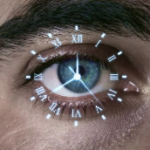Keratoconus
What Is Keratoconus?
A healthy cornea resembles a clear, round dome. Located at the front of the eye, your cornea helps you see by focusing light as it enters through the eye. The structure of the cornea is remarkable. It is 72% protein by weight which makes it the driest tissue in the human body. By contrast, the rest of the human body (with the exception of bone) is 75% water and 25% everything else. The high protein content of the cornea is maintained in a rigid lattice structure of parallel fibers cemented by extensive cross-linking, not unlike the rebar interconnects of reinforced concretes.
For most people, these crosslinks allow the cornea to endure significant trauma over the course of a lifetime without any lasting reduction to vision. Soldiers in close-quarter combat may experience blast waves from explosions, boxers sustain multiple punches to the eye, jiu-jitsu practitioners endure eye gouges in competition bouts, and little kids with runny noses and allergies rub their eyes as hard as they can; yet the cornea maintains its regular lattice structure and retains good vision.
In patients with keratoconus, for reasons that are not fully understood but likely have to do with a mix up in genetics, these crosslinks are missing. Without rebar reinforcement, concrete is brittle and easily shattered. The same is true with keratoconus—without the sturdy crosslinks, the lattice infrastructure of the cornea begins to buckle early in patients’ lives, sometimes as early as in their teens (depending on the severity of their genetically inherited condition) and the cornea begins to bulge outward. The effect changes the ocular surface shape from a smooth bowling ball to a traffic cone.
As the weakened cornea thins centrally and bulges, the optics of the eye become distorted and patients develop blurred, distorted vision and lose the ability to see well even with glasses. They become dependent on a special type of large contact lens that sits on the white of the eyes and vaults over their cone-shaped corneas, forming a new ocular surface with normalized optics. In time these lenses also become difficult to wear, and the disease may progress to the point that the contact lenses become difficult to fit or to put on and take off.
A significant minority of keratoconus patients ultimately cannot wear contact lenses at all and end up requiring a full-thickness corneal transplant to achieve visual restoration.
Although rare, a similar condition to keratoconus can develop called post-LASIK ectasia, in which the cornea starts to bulge forward at a variable time after LASIK, PRK, or Small Incision Lenticule Extraction (SMILE) corneal laser eye surgery.
Symptoms
Signs and symptoms of keratoconus may change as the disease progresses and include:
- Blurred or distorted vision
- Increased sensitivity to bright light
- A need for frequent changes in eyeglass prescriptions
- Sudden worsening or clouding of vision
Causes
Causes of keratoconus include:
- Genetics
- Eye trauma, such as long-term use of hard contacts
- Eye diseases, such as retinitis pigmentosa, retinopathy of prematurity, and vernal keratoconjunctivitis
- Other diseases including Down syndrome, osteogenesis imperfecta, Addison’s disease, Leber’s congenital amaurosis, and Ehlers-Danlos syndrome
Although rare, a similar condition to keratoconus can develop called post-LASIK ectasia, in which the cornea starts to bulge forward at a variable time after LASIK, PRK, or SMILE corneal laser eye surgery.
Treatment
During the beginning stages of the disease, the condition is correctable with glasses or soft contact lenses. As the disease progresses, though, rigid gas permeable contact lenses or other types of lenses are usually necessary.
Based on the condition of your eyes, your eye doctor may also recommend one of the following two treatment options:
Corneal Collagen Cross-linking (PACK-CXL)
To slow the progression of the disease, your ophthalmologist may recommend a corneal collagen cross-linking procedure. This cutting-edge treatment uses a special type of ultraviolet light to stabilize and strengthen the cornea by creating new links between collagen fibers within the cornea. This then slows the changes to the shape and curvature of the cornea.
During a corneal cross-linking procedure, your doctor will first apply riboflavin (vitamin B-12) eye drops and then shine a specific type of ultraviolet light directly onto your cornea. The procedure causes new corneal collagen cross-links to develop, leading to a stiffer, stronger cornea.
Corneal cross-linking is an outpatient procedure that typically lasts about an hour. Patients typically do not experience any discomfort during the procedure thanks to mild sedation and numbing anesthetic drops applied to the eyes.
Corneal Transplant (Keratopathy)
For severe or advanced cases of keratoconus, a corneal transplant may be necessary.
At Ophthalmic Consultants of the Capital Region, our corneal specialist uses a laser-assisted procedure called FLAK (femtosecond laser-assisted penetrating keratoplasty) to remove the damaged cornea and replace it with a donated cornea. The laser technology allows our specialist to create the most optimal fit with the new cornea, resulting in a faster healing of the transplant, quicker recovery of vision, and better optical quality.
Patients don’t feel any pain thanks to the use of a sedative and local anesthetic. During the procedure, your doctor will remove a button-sized disk of the abnormal or diseased corneal tissue and then the donor cornea, cut to fit, is placed in the opening. Your doctor will then use a fine thread to stitch the new cornea into place. The stitches may be removed at a later visit when you have a follow-up appointment with our specialist.
Once the cornea transplant is completed, you can expect to receive several medications including eye drops, wear an eye patch to protect your eye as it heals after surgery, and return for follow-up exams so your cornea specialist can monitor the healing progress and restoration of vision.
Most people who receive a cornea transplant will have their vision at least partially restored, although the majority of people will still need glasses or contact lenses to see clearly.

